

 Knowledge Base +
Knowledge Base +  2024.01.17
2024.01.17800G=8*100G=4*200G, so according to the single-channel rate, it can be mainly divided into two categories, namely. Single-channel 100G and 200G, corresponding to the architecture shown in the figure below. Single-channel 100G optical modules can be landed faster, while 200G has higher requirements for optical devices. At present, the maximum rate supported at the electrical interface is 112Gbps PAM4, and for the case of single-channel 200G, a gearbox is required for conversion.
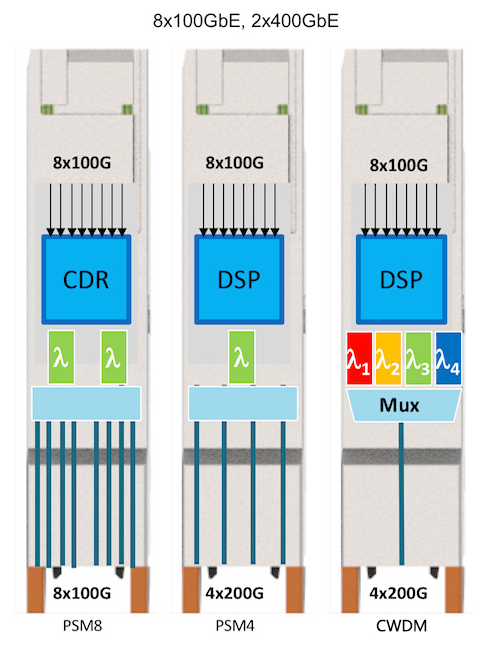
For the multimode case, there are two main standards for 800G optical modules, corresponding to transmission distances up to 100m.
adopts VCSEL solution, wavelength is 850nm, single channel rate is 100Gbps PAM4, need 16 fibers. This can be regarded as an upgraded version of the 400G SR4, doubling the number of channels. The optical interface is MPO-16 or 2 rows of MPO-12, as shown in the figure below.

This solution uses two wavelengths, 850nm/910nm, and transmits signals of both wavelengths in a single fiber in both directions, i.e., the so-called bi-directional transmission, and the module needs to use DeMux to split the two wavelengths. A single channel rate of 100Gbps PAM4, need 8 optical fibers, compared with the SR8, the number of fibers in this scheme to save half. Its block diagram is shown in the following figure.
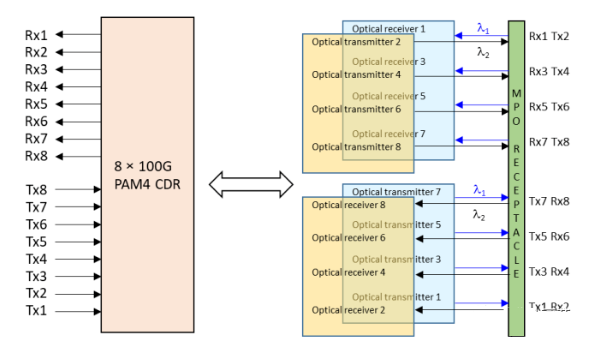
Its optical interface is shown in the following figure, using MPO-12 interface.

For the single-mode case, there exist multiple standards for 800G optical modules
These three standards have similar internal architectures, including 8 Tx and 8 Rx, ! The single channel rate is 100Gbps and requires 16 fibers.
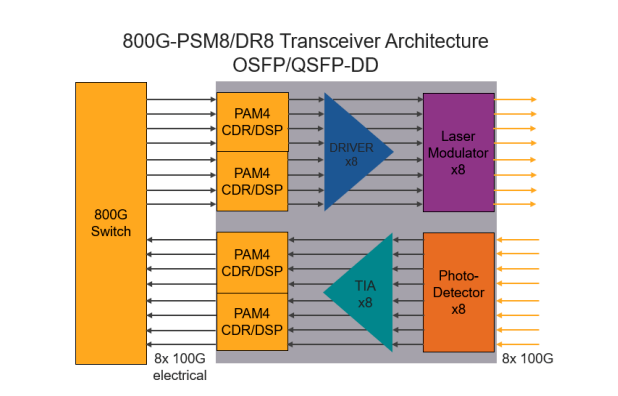
PSM8 has a transmission distance of 100m, while DR8 and 2*DR4 correspond to a transmission distance of 500m 2xDR4 has two MPO-12 optical interfaces, as shown in the figure below, which can be interconnected with 400G DR4 optical modules to facilitate data center upgrades. And the optical interface of PSM8 and DR8 is MPO-16 day photoelectricity.
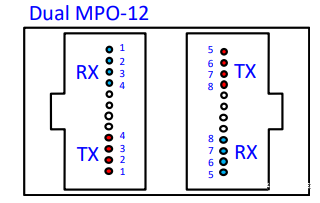
The internal structure of these two standards is similar, containing four wavelengths, single channel rate of 100Gbps, the number of fibers through the Mux to reduce the number of fibers, you need four fibers, as shown in the figure below.
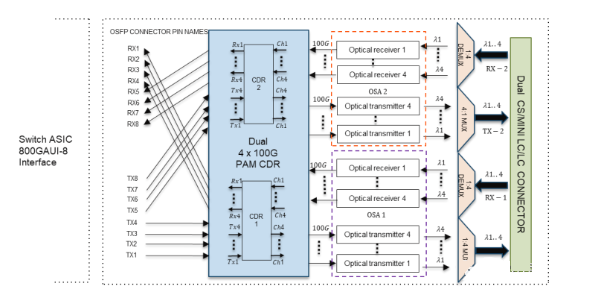
Both solutions are upgrades of 400G FR4 and LR4 optical modules, using CWDM4 wavelengths of 1271/1291/1311/1331nm. 2xFR4 supports a transmission distance of 2km, and 2xLR4 supports a transmission distance of 10km. The optical interface is either dual CS or dual duplex LC.

This solution uses four wavelengths, with a single channel rate of 200Gbps, requires two fibers, and supports a transmission distance of 2km, as shown in the figure below.
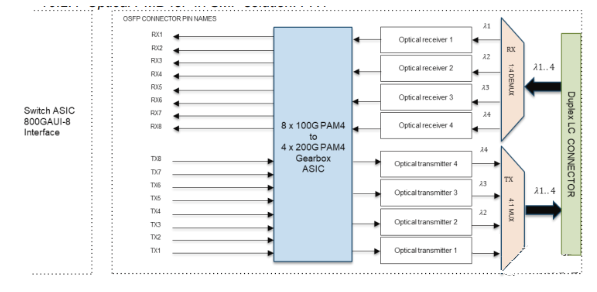
It adopts duplex LC optical interface, as shown in the figure below.
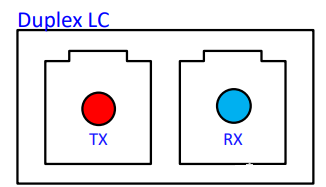
This solution uses eight wavelengths, each wavelength rate of 100Gbps, requires two optical fibers to support 2km transmission distance, as shown in the figure below. The eight wavelength channels are 1271/1291/1311/1331/1351/1371/1391/1411nm.
Both QSFP-DD and OSFP can support 800G, and their pairs are shown in the following figure.
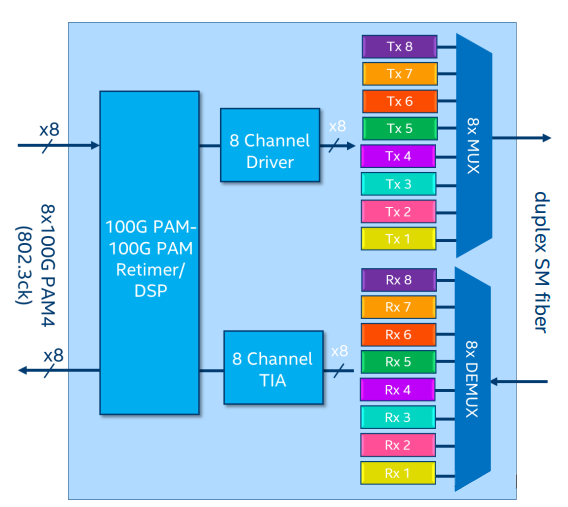
For 800 optical modules, QSFP-DD has made some additional updates, namely QSFP-DD800.
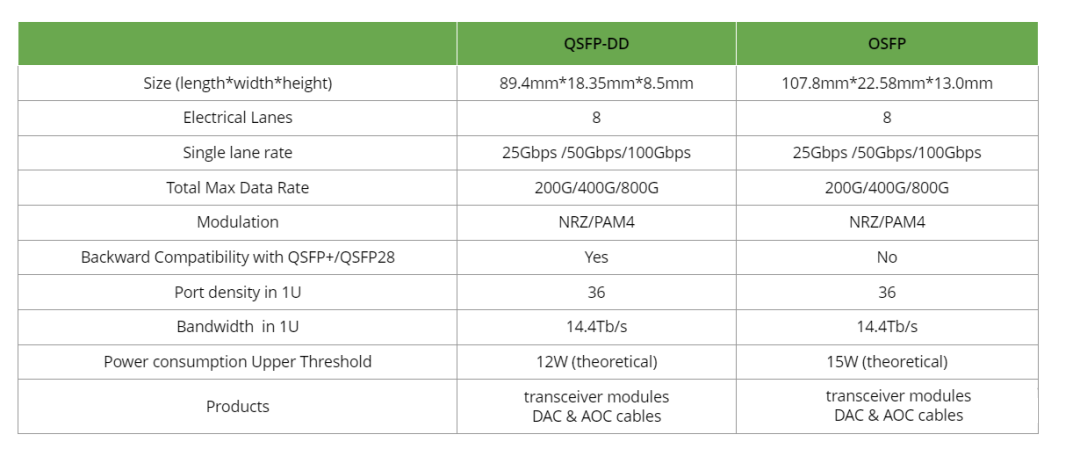
1) Size, OSFP's size is slightly larger.
2) Power consumption, OSFP power consumption is slightly higher than QSFP-DD
3) Compatibility, QSFP-DD is perfectly compatible with QSFP28 and QSFP+, while OSFP is not.
At present, the mass production of single-mode 800G optical modules, mainly using the EML program. Silicon optical program can occupy a place? Not yet known, but also depends on the cost and power consumption. For single-wave 200G solutions, EMML or thin-film potassium acid are two possible technology routes.
Subscribe to the newsletter
for all the latest updates.
2-5# Building, Tongfuyu Industrial Zone, Aiqun Road, Shiyan Street, Baoan District, Shenzhen. China
